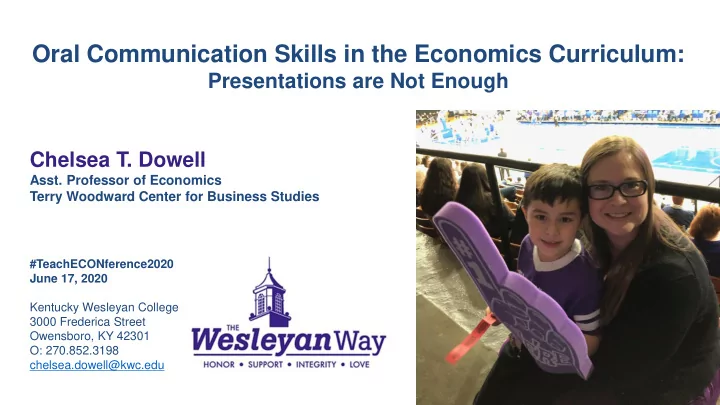

Oral Communication Skills in the Economics Curriculum: Presentations are Not Enough Chelsea T. Dowell Asst. Professor of Economics Terry Woodward Center for Business Studies #TeachECONference2020 June 17, 2020 Kentucky Wesleyan College 3000 Frederica Street Owensboro, KY 42301 O: 270.852.3198 chelsea.dowell@kwc.edu
Who do Ethical businesses Leaders want to hir ire? Professional Creative Communicators Problem-Solvers
Oral communication skills in current economics curricula are mainly assessed using formal presentations… …But Presentations Are NOT ENOUGH
Experiment • Small, Private Liberal Arts University • 3 Sections of Principles of Microeconomics and Macroeconomics • All in Same Semester • All MTRF Classes in 8-Week Sessions • Mid-Morning to Mid-Afternoon • All Same Instructor • 1 Pre-Survey Self-Evaluation • 2 Peer Evaluations • 1 Post-Survey Self-Evaluation • Human Subject Committee (IRB) Approved
Section 1 Section 2 Section 3 Total Class Capacity 25 25 25 75 Enrollment 20 12 23 55 Consenting 18 12 15 45 Participants Present and 16 10 14 40 Data Consenting on Assignment Day White 87.50% 60.00% 71.43% 75.00% Female 25.00% 20.00% 28.57% 25.00% In-State 56.25% 50.00% 54.55% 47.50% Primary Business 81.25% 60.00% 78.57% 75.00% Major
Level 3 L3 Level 2 L2 pts Level 1 L1 pts Grading Criteria pts Active Listening: Student responses indicate that the student heard Attempted And Attempted Did Not his/her peers and their idea(s) were considered. Was Mostly __ Sometimes, But __ Attempt. __ Successful. 1.0 Was Not Always 0.5 0.0 Successful. Professional Diction and Tone: Student uses professional word Attempted And Attempted Did Not choice and tone, including appropriate vocabulary. Was Mostly __ Sometimes, But __ Attempt. __ Successful. 1.0 Was Not Always 0.5 0.0 Successful. Respect: Student respects others’ ideas and opinions. When Attempted And Attempted Did Not receiving criticism (even when the student disagrees), student Was Mostly __ Sometimes, But __ Attempt. __ receives it in a humble manner and tries to view it as constructive. Successful. 1.0 Was Not Always 0.5 0.0 When giving criticism, student attempts to present it in a Successful. constructive manner. Clear and Concise Ideas: Student attempts to contribute Attempted And Attempted Did Not purposeful and relevant ideas. Student clearly and concisely Was Mostly __ Sometimes, But __ Attempt. __ articulates thoughts and arguments. Successful. 1.0 Was Not Always 0.5 0.0 Successful. Positive Attitude: Student maintains a positive attitude (even when Attempted And Attempted Did Not frustrated or confused). Student is appropriately enthusiastic about Was Mostly __ Sometimes, But __ Attempt. __ the subject matter. Successful. 1.0 Was Not Always 0.5 0.0 Successful. Total: ______ / 5
Peer Evaluation Results Grading Scale 1.0 pt Attempted And Was Mostly 0.5 pts Attempted Sometimes, But 0.0 pts Did Not Attempt Successful Was Not Always Successful Criteria Section 1 Section 2 Section 3 All Sections Average Average Average Average Active Listening: Student responses indicate that the student heard his/her 0.9688 1.0000 0.9643 0.9737 peers and their idea(s) were considered. (0.1210) (0.0000) (0.1288) (0.1116) Professional Diction and Tone: Student uses professional word choice and 0.9688 0.9688 0.8929 0.9408 tone, including appropriate vocabulary. (0.1210) (0.1210) (0.2052) (0.1616) Respect: Student respects others’ ideas and opinions. When receiving 1.0000 1.0000 0.9821 0.9934 criticism (even when the student disagrees), student receives it in a humble (0.0000) (0.0000) (0.0928) (0.0570) manner and tries to view it as constructive. When giving criticism, student attempts to present it in a constructive manner. Clear and Concise Ideas: Student attempts to contribute purposeful and 0.9375 0.9375 0.9286 0.9342 relevant ideas. Student clearly and concisely articulates thoughts and (0.1654) (0.1654) (0.1750) (0.1690) arguments. Positive Attitude: Student maintains a positive attitude (even when 1.0000 1.0000 1.0000 1.0000 frustrated or confused). Student is appropriately enthusiastic about the (0.0000) (0.0000) (0.0000) (0.0000) subject matter. Total Score 4.8750 4.9063 4.7679 4.8421 (0.2795) (0.2633) (0.3129) (0.2948) Total Number of Rubric Participating Students 18 10 21 49 Total Number of Observations 36 16 42 94
Self-Evaluation Results How would you describe your oral communication skills? 0 Very Poor 1 Needs 2 Neutral 3 Good 4 Proficient Improvement Pre-Survey Self-Evaluation 0 6 9 23 5 0.00% 13.95% 20.93% 53.49% 11.63% Post-Survey Self-Evaluation 1 2 7 15 11 2.78% 5.56% 19.44% 41.67% 30.56%
How would you describe your professional colleague-to-colleague oral communication skills? 0 Very Poor 1 Needs 2 Neutral 3 Good 4 Proficient Improvement Pre-Survey Self-Evaluation 0 3 12 19 9 0.00% 6.98% 27.91% 44.19% 20.93% Post-Survey Self-Evaluation 0 3 2 14 17 0.00% 8.33% 5.56% 38.89% 47.22%
Choose the response that best represents your agreement with the following statements: The Peer Evaluation assessment method helped me to better understand the goals of colleague-to- colleague interactions. 0 Strongly Disagree 1 Disagree 2 Neutral 3 Agree 4 Strongly Agree 0 1 11 17 7 0.00% 2.78% 30.56% 47.22% 19.44% The Peer Evaluation assessment method improved my oral communication skills. 0 Strongly Disagree 1 Disagree 2 Neutral 3 Agree 4 Strongly Agree 0 2 15 15 4 0.00% 5.56% 41.67% 41.67% 11.11%
The Peer Evaluation assessment method improved my colleague-to-colleague interactions. 0 Strongly Disagree 1 Disagree 2 Neutral 3 Agree 4 Strongly Agree 0 1 13 18 4 0.00% 2.78% 36.11% 50.00% 11.11% The Peer Evaluation assessment method increased my confidence in my colleague-to-colleague interactions. 0 Strongly Disagree 1 Disagree 2 Neutral 3 Agree 4 Strongly Agree 0 2 12 18 4 0.00% 5.56% 33.33% 50.00% 11.11%
Conclusions • Businesses want proficient oral communicators. • Current economics curricula do not do enough to prepare graduates. • Original Assessment Rubric can easily pair with any collaborative learning activity. • New Rubric improves students’ perception of their oral communication skills. • New Rubric increases students’ confidence in their professional colleague-to-colleague dialogue.
Chelsea T. Dowell Asst. Professor of Economics Terry Woodward Center for #TeachECONference2020 Business Studies June 17, 2020 Kentucky Wesleyan College 3000 Frederica Street Owensboro, KY 42301 O: 270.852.3198 chelsea.dowell@kwc.edu Full citations upon request.
Recommend
More recommend